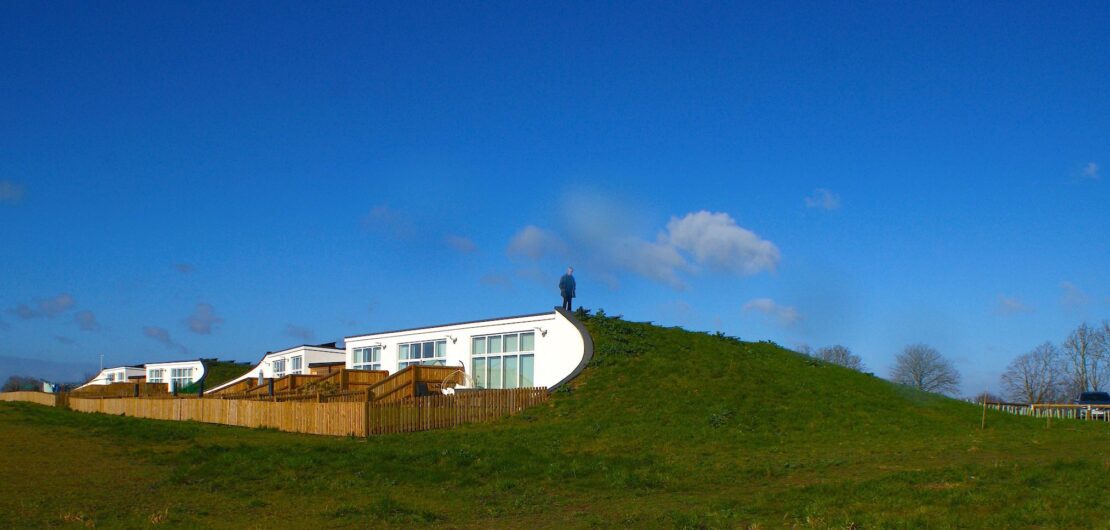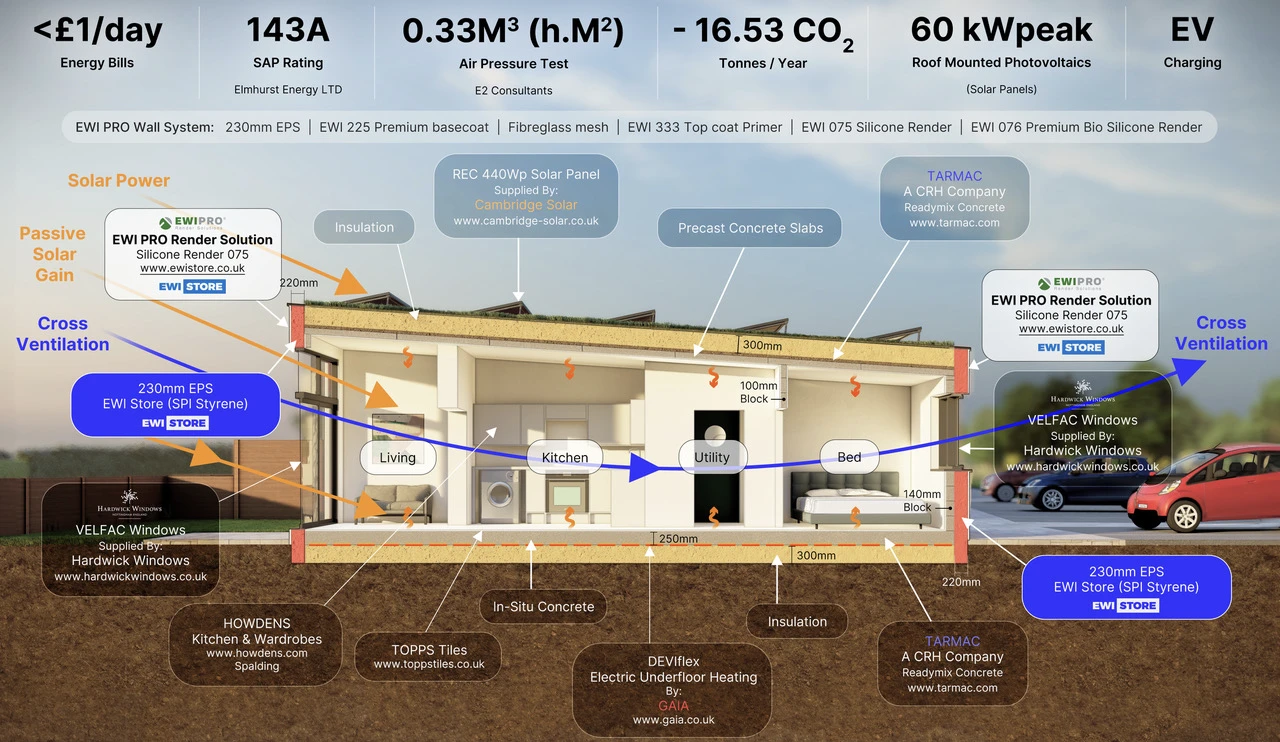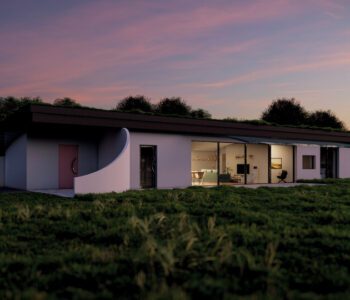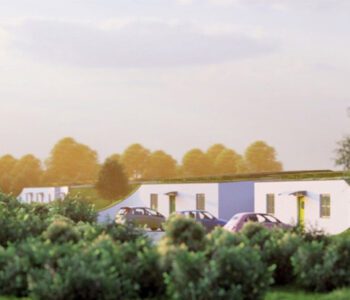
Eco Homes in Howgate Close: Genuinely Affordable Homes
The Eco Homes Project, Howgate Close, is offered as a template for every village in England.
With £1 per day energy bills at Howgate Close, these eco homes are genuinely affordable. Discover more about them here.
Howgate (aka The Eakring Eco Homes) was the vision of Dr. Chris Parsons, a retired GP, and second-generation Eakring farmer. Of most importance is, Dr Parsons project is a replicable alternative to traditional social housing and affordable homes. In addition, he also raised the performance specification compared to other low carbon houses, eco homes and zero carbon homes.
What Is Howgate Close? Overview
Describing Howgate Close as eco-homes is to understate its performance. Most notable are these five 2-bed homes and four 1-bed homes, all operate beyond zero carbon.
For the record, Dr. Parsons first conceived the idea of his replicable development solution in 2015. His intention was to resolve several local issues that have both national and global significance. He observed, a shortage of local affordable rural homes and a progressively diminishing bio-diversity in the surrounding Nottinghamshire countryside.
Eradication of the risk of fuel poverty was a priority for Dr Parsons while nurturing a conducive neighbourhood that mitigates greenhouse gas emissions. He succeeded in his aims. Additional aspects of the model comprise, taking 10 acres out of intensive arable farming, constructs nine homes for rent and installs 60KW’s of solar panels (142 panels) He’s also planting 10,000 trees and hedgerow, creating wildflower meadows, scrubland, and a wetland.
“..an opportunity to address some of society’s most pressing issues: rural housing shortages, climate change, soil restoration, carbon sequestration, biodiversity, water management, and community cohesiveness.”
Dr. Parsons
(as reported in CLA Magazine)
Furthermore, this Case Study demonstrates these eco homes are a viable alternative to conventional social housing and affordable homes. Equally important, They also deliver a new level of energy efficiency and carbon mitigation associated with Eco Homes or Zero Carbon Homes.
Eco Homes Provide An Acceptable Return On Investment (ROI)
In evaluating the viability of Dr. Parsons model, it’s useful to refer to Howgate’s Return On Investment (ROI). Usefully, the model’s efficiency of investment is assessed on several levels; economic, carbon emissions, social and community integration.
First, at an economic level, Howgate achieves a 5% ROI with a 20-year payback period (Amortisation) using conventional financial performance measures.
Second, carbon emissions provide another performance metric with national and global implications. According to the nine Energy Performance Certificates (EPC’s), the homes collectively mitigate 16 tonnes of carbon emissions each year from their renewable energy generation. Adding a further 9 tonnes annually of carbon sequestration annually is the re-wilding of 9 acres. Consequently, the site’s Biodiversity Net Gain (BNG) will likely exceed Natural England’s soon-to-be mandatory minimum 10% benchmark.
Furthermore, full financial benefits of the 60KW’s of roof-mounted photovoltaics are given to Howgate’s residents. Consequently, first 10 months’ energy bills, average less than £1 per day across all nine homes. 54pence/day as of 12th July 2023.
It should be noted that Dr Parsons investment returns at Howgate Close compare favourably to their financial cost.
“Howgate Close epitomises the aims of the Councils De-Carbonisation Plan and would encourage more of the same.”
John Robinson
(CEO Newark & Sherwood District Council)
2023
Included later, is detail on Howgate’s social and community integration.



Planning Permission For Eakring Eco Homes
Gaining Planning Permission 16/819/FULM for Howgate Close is now a legal and planning precedent. Newark & Sherwood District Council (NSDC) refused the 2016 planning application, which was subsequently approved on Appeal 23.01.18.
In contention was the principle as to whether the development constituted isolated development in the open countryside. Thankfully, the Appeal Inspector Mr Lyons, said that, in the light of a recent High Court decision, it did not and that the proposal offered particular benefits in terms of;
“The houses’ environmental performance and their support for the economic and social viability of the rural community, underpinned by their controlled occupancy, low running costs and restricted sales values, and by the creation of ecologically enhanced publicly accessible green space.”
Helpfully, Mr. Lyons conclusion is the project contributes to the rural area’s economic and social vitality, accorded within the NPPF.
Subsequently, the Appeal Decision was contested through the High Court where Mr. Justice Soole presiding over the case, provided a High Court Judgement that found the Inspector’s original analysis was;
“an unimpeachable judgment on planning ….”
For the duration of the Planning Application, the Appeal and the High Court Case, Howgate Close is called the Eakring Eco Homes project. During those process’s a distinction was made between Eakring’s Eco Homes and traditional social and affordable homes.
“Howgate Close’, is a template for the creation of woodland and meadow for every village in England, funded, by genuinely affordable local homes for local people.”
Dr. Chris Parsons
(Howgate Close Owner)
Design Origin Of Howgate’s Eco Homes
Hockerton Housing Project (HHP) design for the Eakring Eco Homes project, uses the design principles applied at HHP. The HHP’s Architects, are Professors Brenda and Robert Vale, The Vale’s.
These design principles were first published in The Vale’s 1975 book, ‘The Autonomous House’, and implemented at their former Southwell home, ‘The New Autonomous House’. It’s worth noting, that over 40 years later, The Vale’s design principles have been applied less than 7 miles from The Vale’s former home. To their credit, on July 27th 1994 their Southwell home became the UK’s first dwelling to export photovoltaic-generated renewable energy to the National Grid.
“What makes the Eakring (Eco Homes) project truly exceptional is the unique combined experience of the HHP design team. A team that has twenty-four years of designing, constructing, maintaining, and servicing the UK’s largest collection of autonomous earth-sheltered buildings.”
Final Assessment Report
Compliance with Condition 12
Newark & Sherwood District Council
July 2019
Prior to construction, Dr Parsons undertook technical adjustments to the approved design raising the EPC Rating from a SAP Rating of 84 to 143.
Design Principles
Introduced in detail below, are Howgate’s design principles. Also provided is third-party verification of their performance via the Standard Assessment Procedure (SAP).
Passive Solar Design Techniques
Intrinsic to the buildings performance, is the utilisation of the passive solar design principles pioneered by The Vale’s. HHP’s application of these techniques include;
- Southerly orientation
- High thermal mass superstructure
- Super-insulated envelope
- Renewable energy
Further specification enhancements at Howgate Close include;
- Solid external walls (no cavities)
- Floating slab (no foundations)
- Contiguous external insulated envelope (no cold bridging)
- Triple glazing
- Reduced reliance on mechanical ventilation
- Back-up electric underfloor heating
- Externally located window and door jambs (improved Psi values)
- Hot water demand at source (no stored hot water)



Standard Assessment Procedure (SAP)
It’s important to recognise, that these design principles produced some of the highest As-Built SAP Ratings in the UK and are recorded on The EPC Register. Consequently, calculations undertaken by Elmhurst Energy produced SAP Ratings of 143A (2bed) and 129A (1bed) Such is the innovation of Howgate Close, these homes are ranked in the top 0.01% of 12 million registered EPC’s.
As a result of these calculations, it can stated that the development at Eakring operates beyond the UK Governments’ zero carbon standard, Net Zero Law.
It is reasonable to refer to Howgate Close as amongst the UK’s most energy-efficient collection of dwellings.



Residual Heat Reservoirs
Stable internal air temperatures are a defining characteristic of high thermal mass buildings. Specifically, thermal mass is provided by concrete products, tiles, and render, as at Howgate. For clarity, the phenomenon responsible for stabilising internal air temperatures is a ‘residual heat reservoir’.
Absent from Howgate is a conventional heating source, passive heat energy (solar gains, people, and appliances) is retained within the thermal mass of the superstructure. Subsequently, the retained heat energy is sufficient to sustain elevated internal air temperatures ranging from 19C to 23C.
As a consequence, Howgate’s homes can be referred to as ‘zero heated buildings’[i] Evidence of this status is being delivered via the energy bills of Octopus. Such is the exceptional performance, that over their first winter (2022/2023) recorded average internal air temperatures are circa 21 degrees centigrade with an annual internal air temperature variance of four degrees (+/- 2oC)
Further evidence is to be provided via empirical evidence gathered in collaboration with Nottingham Trent University (NTU) Meanwhile, the NTU team is measuring in-use building performance which is cited in Dr Harrall’s peer-reviewed science paper. Future updates on the paper’s publication and presentation in Singapore at the Associated Research Centres for Urban Underground Space (ACUUS) 2023 Conference, are to be provided via www.drharrall.com.
Project Construction Specification
An important distinction in Howgate’s construction specification, is what’s not included, rather than what is included. That means, there are no ground source heat pumps, no air source heat pumps, no cavity walls, no roof trusses, no traditional foundations, no stud partitioning, the list goes on.



| External Walls | Silicone Render EWIPro,240mm Expanded Polystyrene ( SPI ) Tanking Membrane 140mm 7N/mm2 Dense Concrete Block, Sponge Float finish silicone render: External Wall U-Value is 0.13W/m2K |
| Floor | Ceramic Tiles 200mm Topps Tiles, In-situ concrete slab (Tarmac) 1KWpeak DEVIflex Electric Underfloor Heating (Gaia) Tanking Membrane, 300mm Ravatherm Extruded Polystyrene (Ravago) 200mm Hardcore: Floor U-Value is 0.07W/m2K |
| Roof | 220mm prestressed concrete planks 100mm in-situ concrete slab (Tarmac) Tanking Membrane, 300mm Ravatherm Extruded Polystyrene (Ravago) Tanking Membrane, REC 440Wpeak Photovoltaic Panels (Cambridge Solar) : Roof U-Value is 0.08W/m2K |
| Space Heating | 1KW DEVIflex electric underfloor heating (Gaia) |
| Ventilation | Greenwood CV2 Extract Fans |
| Windows & Doors | VELFAC Triple Glazed windows (Hardwick Windows) |
| Kitchens & Wardrobes | Howdens |
| Photovoltaics | 60KW REC440Wpeak panels (Cambridge Solar) |
| Invertor | 12KW Fronius (Cambridge Solar) |
| EV Charging | Wiring Installed |
| Waste Treatment | 10,000litre Septic Tank |
| Wetland Area & Pond | Two ponds covering approximately half an acre with a variety of wetland plants |
| Rewilding | 9acres planted with trees, hedgerow, shrubs, grasses and wild flowers |
Construction Cost Of Howgate Close Eco Homes
Howgate comprises, nine homes, 5no. 2beds (63m2) and 4no.1beds (41m2) with a gross development floor area of 479m2. Rather generously, the eco homes are accommodated within 1-acre of the 10-acre site.
Demonstrating Howgate’s viability, its total project cost was £1.5m with construction costs of £2,100 m². Thankfully, these costs compare favourably with £1,800 m² for a conventional dwelling and £2,200-2,400 m² for a Passive House. As a result, Howgate’s development ROI is 4.6%.
For clarification, these costs are significantly higher than the traditional social housing units built today. In contrast, Howgate’s running costs are significantly lower. In another Case Study, the ‘true cost of ownership’ is to be explored.
Neighourhood & Community
It should be noted, part of Dr. Chris Parsons project aspiration, was to see embedded at Howgate, a strong sense of community with a safe living environment. To this end, Howgate’s households comprise a mixed demographic, the youngest resident is 8 years and the oldest is 78 years old. Other residents include, a mother and adult daughter living in neighbouring properties. Furthermore, there are three retired households, with two households working from home, and other households working locally, one on Dr. Chris Parsons Eakring Farm. Seven of the nine households already knew each other prior to moving into Howgate.
“Our tenants came by word of mouth and short of life crises, look as if they will be long-term residents,”
Dr. Chris Parsons
(as reported in The Sunday Times)
Encouragingly, Howgate Close demonstrates the traits of what a post-hydrocarbon neighbourhood might look like. Such traits are, energy independence, autonomy of essential resources, on-site waste management, transitioning towards fossil-fuel-free lifestyles and a strong community spirit. It’s these very traits that Howgate’s eco homes comprises; fossil-fuel-free in operation, generating a surplus of energy, managing their own wastewater on site with most homes not experiencing heating bills.
Post Hydrocarbon Ready
“The post-hydrocarbon era will not appear suddenly. Gradual change and individual decisions will aggregate into wide structures beyond the scope of the individual decisions.”
Dr. Ali Cerri
Post Hydrocarbon People
Material to Dr Parsons vision, the key findings from a recent City of London study, Almhouses Longevity Study, found that residents in almshouses in England are receiving a longevity boost of 2.4 years, an extra 15% of future lifetime. Not surprisingly, longevity boost was attributed to ‘a strong sense of community and social interaction’. In turn, this ‘leads to better physical and mental health and helps combat the loneliness epidemic’. Encouragingly, the report recommended that future housing models for the UK should epitomise ‘a good living environment, include companionship, community and independent living’. Thankfully, all these traits are identified in the Eakring Eco Homes development.
“Our conclusion is that almshouses (or their equivalents) could help in the Government’s aim to reduce mortality inequalities…“
Bayes Business School
City University of London
2023
Not surprisingly, achieving the UK Government’s aim in reducing mortality rates will be the subject of metrics for another generation.
Rental Model For Eco Homes
Unusually, Dr. Chris Parsons rental model forms an integral part of the Planning Consent Section 106 Agreement. In particular, the model allows the properties should be rented to local people for at least 15 years after which they may be sold. If they are sold, they would be priced at 80% of market value and need to be advertised foo local people. with the future selling price pegged at 80% of their open market value.
Whereas, a review of the current rental housing market for ‘eco homes’ and ‘eco houses’, is in contrast. Unlike Howgate, these homes are of a lower performance specification and demand higher rents. Such a review, provides further evidence that Howgate Close is truly affordable.
Also secured via the S106 Agreement, is that the properties, whether rented or sold, can only be occupied by residents with a local connection to the parish, either through residency, employment or caring responsibilities. Even before the homes were completed, eight of the nine were let to households working in local businesses. Most beneficial for the tenants, rental levels are set at 90% of the open market rental value, with a further 10% service charge for the power from the pv’s, sewerage and ground maintenance..
“For me the rental security is important. It would break my heart to move from here….”
Jennifer Edwards
(Tenant, as quoted in The Sunday Times )
A Summary
Exceptionally low average energy bills, at 54pence a day, means, the Howgate Close development can legitimately lay claim to being ‘truly affordable’ homes.
In addition, Dr. Chris Parsons vision has produced a viable financial and environmental responsible model. It’s also a model that is replicable.
Importantly, additional third party verification of Howgate’s performance, in the form of peer-reviewed publications, is to be provided by NTU.
Finally, Howgate has informed ‘Tork Lane Cottage’, Dr. Parsons next project. This eco house has brokered off-grid capability, introduces energy storage facilities (batteries) and will deliver a SAP Rating in the region of 160A.
An Afterward
What distinguishes Howgate’s Case Study, is that it limits the use of fashionable words and phrases in common use in this sector. For example, some of these words have become to a degree misleading. Instead, more specific word and phrases are used providing clarity, deliberately avoiding confusing terms. Compounding the issue are the website algorithms emphasis on keywords and SEO, resulting in unnecessary repetition.
One such phrase, Sustainable Development was first defined in a global context by the World Commission on Environment and Development’s in 1987. Its Chairperson, Gro Harlem Brundtland, provided the Foreward to ´Our Common Future’. It’s in this landmark publication the following definition first appeared,
‘development that meets the needs of the present without compromising the ability of future generations to meet their own needs‘
During the 37 years following this publication, the phrase, sustainable development and its derivative sustainability, have become synonymous with all forms of development. Almost nothing has been left untouched by these terms. Such examples include, manufactured goods, corporate and social policies, political agendas and holiday packages. Unhelpfully, the proliferation of the terms use across all forms of media has blurred some lines and detail. So much so, it’s not always clear what exactly is intended.
Other spin-out words and phrases i.e. eco, green, eco-friendly, eco homes, are now so over-used in common parlance, that they are trite and sometimes called ‘greenwash’.
Finally, the disproportionate weight applied to the role of the greenhouse gas, carbon dioxide (carbon) has villainised it. Rarely mentioned are the other manmade gases, methane and nitrous oxide. Like carbon, these gases are also responsible for the warming of Earth and accelerated climate change. Auditing carbon occurs in every aspect of our lives, introducing phrases e.g. zero-carbon, carbon neutrality, net-zero and low carbon. What do they all mean!




